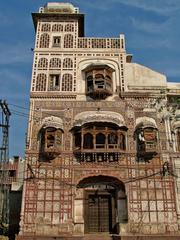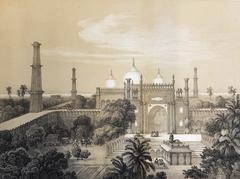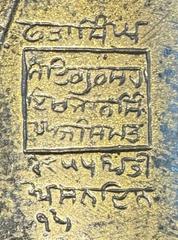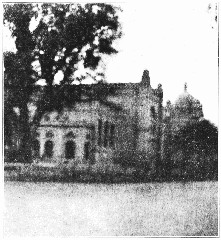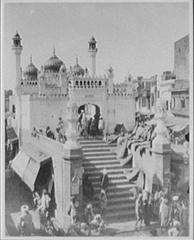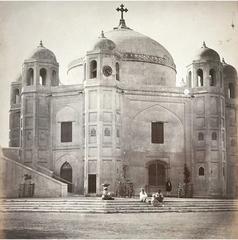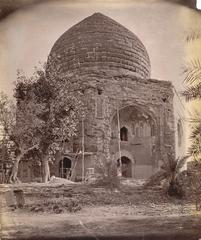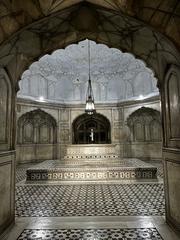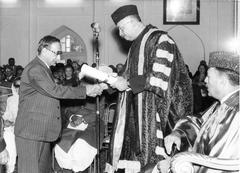Data Durbar Complex: Visiting Hours, Tickets, and Historical Significance in Lahore
Date: 03/07/2025
Introduction
Data Durbar Complex, located near Bhati Gate in the old city of Lahore, Pakistan, stands as one of South Asia’s most significant Sufi shrines. Dedicated to the 11th-century Persian saint Abul Hassan Ali Hujwiri—known as Data Ganj Bakhsh—the complex is a center of spiritual devotion, architectural splendor, and communal harmony. As the largest Sufi shrine in South Asia, Data Durbar not only attracts millions of pilgrims and tourists annually but also plays a vital role in Lahore’s cultural and social landscape (Wikipedia, Pakistan Traveler).
This detailed guide explores the history, spiritual significance, architectural highlights, visiting hours, ticket and entry information, accessibility, travel tips, and nearby attractions to ensure a meaningful and well-prepared visit to this iconic site.
Table of Contents
- Introduction
- Historical Origins and Development
- Mughal, Colonial, and Modern Transformations
- Religious and Cultural Significance
- Visiting Hours and Entry Information
- Accessibility and Visitor Services
- Rituals and Festivals
- Travel Tips and Nearby Attractions
- Architectural Highlights
- Safety and Security
- Frequently Asked Questions (FAQ)
- Conclusion and Summary
- References
Historical Origins and Development
The origins of Data Durbar date back to the 11th century CE, when Abul Hassan Ali Hujwiri arrived in Lahore from Ghazni (present-day Afghanistan). He was a renowned Sufi mystic, theologian, and author of the influential treatise Kashf al-Mahjub (“Unveiling of the Veiled”), a seminal work on Islamic mysticism. Ali Hujwiri established a mosque and was later buried beside it, marking the genesis of what would become the Data Durbar shrine (Graana).
Initially a modest grave near a mosque, the shrine’s reputation grew as Ali Hujwiri’s teachings spread, making it a focal point for spiritual seekers and Sufi pilgrims (Meshpedia). By the 13th century, the site had become a well-established destination for veneration and pilgrimage (Pyaraskardu).
Mughal, Colonial, and Modern Transformations
During the Mughal era, the shrine received significant royal and local patronage, resulting in the construction of the marble mausoleum, expanded courtyards, and architectural embellishments characteristic of Mughal aesthetics (Blizin, Pyaraskardu). This period solidified Data Durbar’s role as a center for Sufi learning and spiritual gatherings.
Under British colonial rule and into the 20th century, the complex underwent several expansions and restorations to accommodate the growing influx of pilgrims. Major redevelopment in the 1980s transformed Data Durbar into South Asia’s largest Sufi shrine, with new courtyards, mosque facilities, and social welfare institutions added to the site (Pakistan Traveler). Today, the shrine is managed by the Punjab Auqaf Board, which oversees its maintenance, religious activities, and charitable services.
Religious and Cultural Significance
Data Durbar is revered for its association with Ali Hujwiri, whose inclusive teachings emphasized love, tolerance, and service to humanity. His Kashf al-Mahjub remains foundational in Sufi literature (Meshpedia). The shrine attracts between 30,000 and 60,000 visitors daily, with numbers exceeding one million during the annual Urs festival, which commemorates the saint’s death anniversary (Wikipedia, Graana).
The Urs festival is celebrated with devotional music (qawwali), prayers, communal meals (langar), and rituals that foster communal harmony and spiritual connection. Data Durbar’s open-door policy and free entry reflect the egalitarian spirit of Sufism, welcoming people of all backgrounds and faiths (Traveler Trails, Guide to Pakistan).
Visiting Hours and Entry Information
- Standard Visiting Hours: The Data Durbar Complex is open to visitors 24 hours a day, seven days a week. However, the best times to visit are early morning (before 8:00 AM) or late evening (after Maghrib prayers) to avoid the largest crowds (Wanderlog).
- Entry Fee: There is no entrance fee; access is free for all visitors.
- Special Events: During the annual Urs festival or other religious events, visiting hours may be adjusted, and crowd levels increase significantly.
Note: Security checks are standard at entry points. Large bags and professional photography equipment may not be permitted.
Accessibility and Visitor Services
- Physical Accessibility: The shrine is accessible to elderly and differently-abled visitors via ramps and accessible pathways. However, some inner areas may have steps or uneven surfaces; assistance is generally available from staff.
- Restrooms: Public restrooms are available within the complex; basic facilities are provided.
- Langar (Community Kitchen): Free meals are served daily, open to all regardless of background or faith.
- Guided Tours: Local guides and agencies offer tours, particularly during festivals and for international visitors.
Rituals and Festivals
Daily Devotions
Visitors participate in Qur’an recitations, chadar (cloth) offerings at the tomb, lighting lamps, and giving charity through the langar.
Qawwali and Sufi Music
Qawwali sessions are held regularly, especially on Thursday evenings and during religious festivals. These musical gatherings are a key highlight and are open to all visitors.
Urs Festival
The Urs of Hazrat Ali Hujwiri, held annually in the Islamic month of Safar, is the most significant event at Data Durbar. The festival features grand illuminations, qawwali marathons, special prayers, and extensive langar service, attracting pilgrims from across South Asia (Pyaraskardu).
Travel Tips and Nearby Attractions
- Dress Code: Modest attire is mandatory. Men should wear long trousers and shirts; women should cover their heads and wear clothing that covers arms and legs.
- Footwear: Shoes must be removed before entering the main shrine. Shoe racks are provided.
- Transport: The shrine is easily accessible via Lahore’s Metrobus (nearest stop: Bhati Chowk), taxis, rickshaws, and ride-hailing services.
- Nearby Attractions:
- Lahore Fort (World Heritage Site)
- Badshahi Mosque (one of the world’s largest mosques)
- Shalimar Gardens
- Walled City of Lahore
- Anarkali Bazaar (historic market)
Architectural Highlights
- Layout: The complex spans 51,000 square feet and features interconnected courtyards, the main mausoleum, Jamia Masjid Data Darbar, and various support facilities (Dawn).
- Tomb Chamber: The central tomb, enclosed by a marble jali screen, is decorated with mirror work, Quranic calligraphy, and green-and-gold symbolic cloths.
- Domes and Minarets: The main dome rises 40 feet, flanked by octagonal minarets decorated with blue and white tilework (Pakistan Today).
- Decorative Arts: The shrine is renowned for its kashi kari (glazed tilework), marble inlay, and mirror mosaic ceilings (Archnet).
- Courtyards: Multiple marble-paved courtyards with shaded canopies provide spaces for gatherings and reflection.
Safety and Security
- Security Measures: The complex is equipped with perimeter walls, metal detectors, and surveillance cameras (BBC).
- Visitor Safety: Security personnel are present throughout; cooperate with all checks. Avoid carrying large bags or valuables during busy periods.
- Health: Carry bottled water, use hand sanitizer, and be cautious with food from outside vendors.
Frequently Asked Questions (FAQ)
Q: What are the visiting hours of Data Durbar?
A: The shrine is open 24/7, but early mornings and late evenings are best for visits.
Q: Is there an entrance fee?
A: No, entry is free for all visitors.
Q: Are guided tours available?
A: Yes, guided tours can be arranged through local agencies or at the entrance, especially during festivals.
Q: Are non-Muslims allowed?
A: Non-Muslims are welcome to visit but should avoid entering during peak prayer times and show respect for religious practices.
Q: Is Data Durbar accessible for differently-abled visitors?
A: Most areas are accessible via ramps, but some inner sections may require assistance.
Q: Can I take photographs?
A: Photography is allowed in courtyards and exterior areas; it is prohibited inside the main shrine and during prayer times.
Conclusion and Summary
Data Durbar Lahore endures as a vibrant symbol of the city’s spiritual, cultural, and architectural legacy. Its open, inclusive ethos welcomes millions, regardless of background, and its blend of Mughal, colonial, and modern influences offers a unique visual and spiritual experience. The shrine’s daily rituals, qawwali sessions, and community outreach programs continue to foster unity and service, making Data Durbar not only a monument of the past but a living center of Lahore’s identity.
For the most up-to-date information on visiting hours, guided tours, and cultural events, download the Audiala app and follow official tourism resources.
References
- Wikipedia
- Pakistan Traveler
- Graana
- Meshpedia
- Pyaraskardu
- Archnet
- Dawn
- Touristlink
- Wanderlog
- Guide to Pakistan
- Pakistan Today
- BBC
